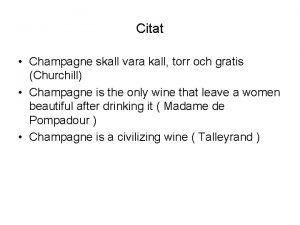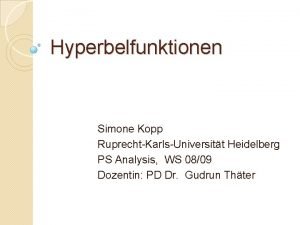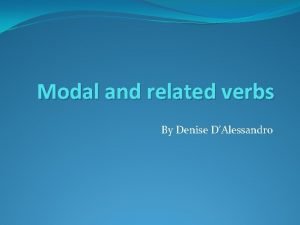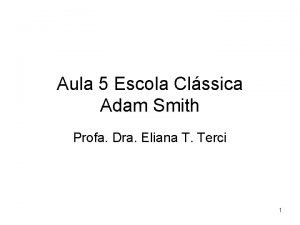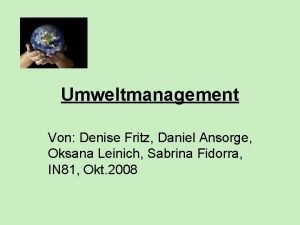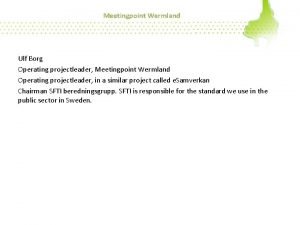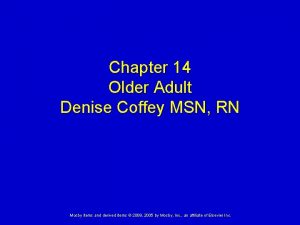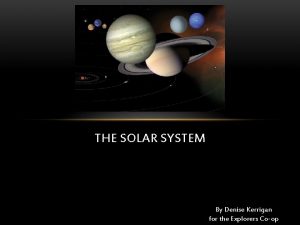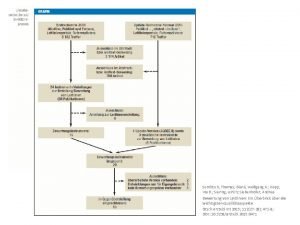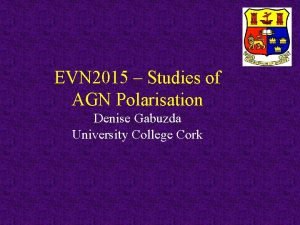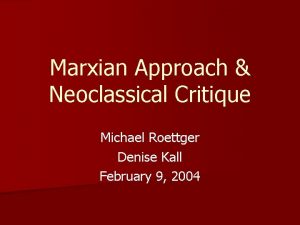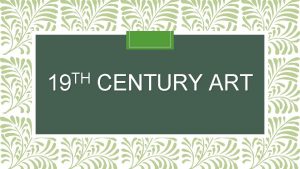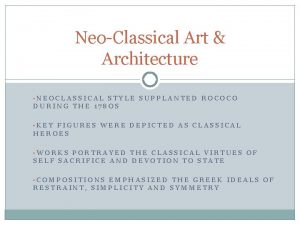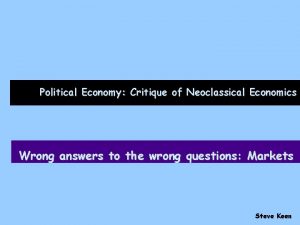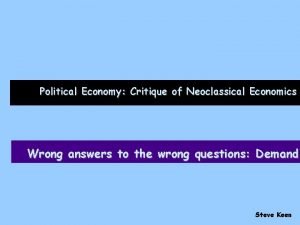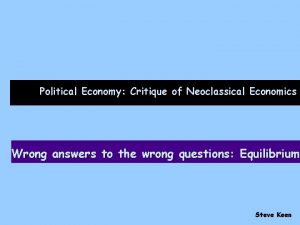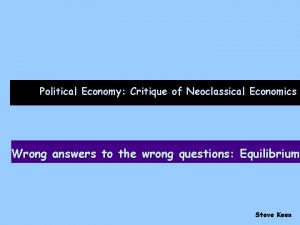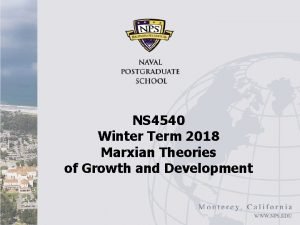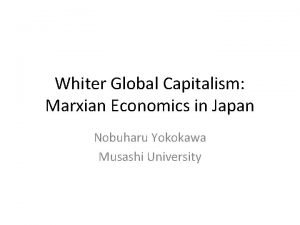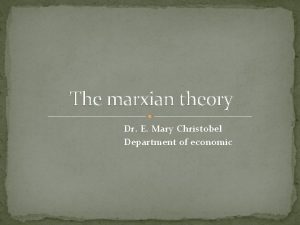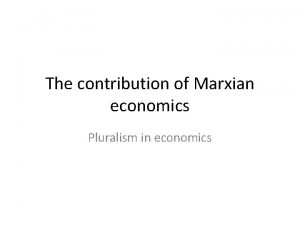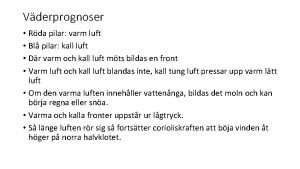Marxian Approach Neoclassical Critique Michael Roettger Denise Kall






































- Slides: 38

Marxian Approach & Neoclassical Critique Michael Roettger Denise Kall February 9, 2004

Overview n I. Biography of Karl Marx n II. Marxist Theory by Marx n III. Critiques of Marx n IV. Neo-Marxist Theory

I. Biography of Karl Marx

I. Marx: Background §Born to a Jewish family on May 5, 1818 to a middle-class family in Trier, Prussia. Marx’s father, facing religious persecution in his legal practice, raised Marx in a Protestant home, despite coming from a long line of Rabbis. This background would later influence Marx’s views on religion and history. §Marx, a brilliant young scholar, enrolled at the age of 17 at the University of Bonn and later at the University of Berlin, finally completing a doctorate in philosophy in 1842.

I. Marx: Background, cont. While at the University of Bonn, Marx became engaged to Jenny von Westphalen. She was the daughter of Baron von Westphalen , a prominent member of Trier society. She and Marx married in 1842 and had three children. n While a student, Marx became a member of the Young Hegelian movement. This group, which included theologians Bruno Bauer and David Friedrich Strauss, produced a radical critique of Christianity which led to Marx becoming unable to find a university position in Prussia. n

I. Marx: Background, cont. Marx, unable to find university employment, became editor of the influential paper the Rheinische Zeitung. Marx’s political commentary and questioning of the Prussian government resulted in government closure of the paper in 1843. Marx then immigrated to Paris. n While in Paris, Marx encountered groups of German and French socialists. In attempting to unify socialism with the Young Hegelian movement, Marx began to formuate a humanistic communism. These writings became his Economic and Philosophical Manuscripts. n

I. Marx: Background, cont. n While in Paris, Marx also became acquainted with Freidrich Engels. Their activities and writings led to their expulsion in 1844. Marx and Engels proceeded to move to Brussels. While in Brussels, Marx formulated his “materialist concept” of history and the eternal struggles between the Bourgeoisie and Proletariat. Marx also predicted the demise of industrial societies and the eventual rise of communistic societies through revolutions by exploited workers.

I. Marx: Background, cont. In 1847, Marx and Engels became involved with the Communist League, a group of German dissidents based in London. Marx and Engels were there commissioned to write The Communist Manifesto, published later in 1848. n In 1848, after a revolution in France, Marx relocated to Paris and then Germany, where he established the Neue Rheinische Zeitung. The Prussian government suppressed Marx’s paper, forcing Marx into permanent exile in London. n

I. Marx: Background, cont. n While in London, Marx and his family (his wife and six children), lived in great poverty. Marx was supported by Engels and a job as a foreign correspondent for the New York Daily Tribune. During this period, Marx spent substantial time supporting communist movements and preparing to write a general critique of capitalism.

I. Marx: Background, cont. In the early 1860’s, Marx commenced writing the three (incomplete) volumes of Das Capital remains, along with the Communist Manifesto, the hallmark of Marx’s writings and a classic in philosophy, economics and sociology. n Marx, in failing health and suffering from the loss of his eldest daughter and wife, began to slow in his political advocacy and writings in the 1870’s. Marx died quietly in 1882, impoverished but the father of one of the most influential social theories of the twentieth century. n

II. Marxist Theory

“Classes in Capitalism and Pre. Capitalism” (Marx) n n n Class struggle has existed throughout history in all types of societies Rise of the bourgeoisie Capitalist society- conflict of bourgeoisie and proletariat Middle-class will gradually sink into the proletariat Proletarian revolution Classless society

“Alienation and Social Class” (Marx) Alienation of man from: 1. the labor of products 2. the processes of production 3. man’s own nature 4. fellow man Alienated labor Private property

“Value and Surplus Value” (Marx) Labor is the common social substance of all commodities Commodity has value because it is a “crystallization of social labor” n Value of laboring power is determined by the value of the necessaries required to maintain and perpetuate the worker n The rate of surplus value depends on the proportion between the part of the day necessary to reproduce the value of the laboring power and the extra or surplus labor performed while producing beyond that which is necessary to maintain the worker. In a capitalist economy, this surplus value from production goes solely to benefit the capitalist. n n

“Ideology and Class” (Marx) “the class which is the ruling material force of society, is at the same time its ruling intellectual force”

III. Critiques of Marx n A. Lenski n B. Samuelson n C. Dahrendorf

III. Critiques of Marxism, Lenski n Comment on sociologist’s focus on Western capitalist societies, failure to examine the fall of communism in Eastern Europe and plight of existing Communist societies in Asia. n Argues that a sufficient body of evidence exists to analyze the nature of inequality in Communist societies

III. Critiques of Marxism, Lenski, cont. Analysis: Societies generally reduce general social inequality, but do so at the general expense of economic productivity, economic growth, and meeting the populations needs of goods and resources. n The persistence of political inequality, corruption, and reforms of human nature failed to materialize, despite Marx’s forceful arguments that these would disappear with the abolition of private property rights in a communist society. n

III. Critiques of Marxism, Lenski, cont. Eastern European worker: “They pretend to pay us, we pretend to work. ” n Findings that elimination of wage structures eliminated incentives for individuals to attain greater wealth. n Davis’ 1953 assertion that successful incentive systems 1. ) motivate the best qualified people to seek the most important positions and 2. ) motivate them to perform to the best of their ability once they are in these positions. n

III. Critiques of Marxism, Lenski, continued. n Massive social inequality and inefficiencies were observed at an unprecedented scale. n Nicolae Ceaucescu, Todor Zhikov, Erich Honecker, and other Communist leaders accrued vast amounts of wealth along with other party elites in almost all Communist societies while extreme poverty existed among the population.

III. Critiques of Marxism, Lenski, continued. n Leaders such as Stalin and China during the “Great Leap Forward” exercised totalitarian control over populations. Stalin’s Russian purges of millions of political dissidents and export of grain when approximately 30 million citizens were dying of starvation illustrate massive human rights violations under guise of political rule.

III. Critiques of Marxism, Lenski, continued n Traditional criticisms of classical industrial economies hold, but do not validate these systems as best forms of social order. n Successful communist and Western democracies have practiced mixed economies, where adaptation of market reforms and implementation of government regulation and oversight offer best examples of government.

III. Critiques of Marxism, Lenski, continued How does Michael Burawoy’s postulate that Marxism may be viewed as a scientific enterprise effect Lenski’s critique? n Do the “laboratory” of former and current Communist countries represent good models for evaluating Marxism? n Is extension beyond classical Marxist theory to incorporate class, power, race, sex, and institutions of any value beyond intellectual or theoretical pursuits? n

III. Critiques of Marxism, Paul Samuelson n Samuelson’s Background: 1970 Nobel Laureate in economics and widely viewed as a father of modern economic theory. Work spans over five decades, beginning with a dissertation in the late 1940’s. n The selected text reading is from Samuelson’s introductory economic text widely used in introductory economic courses for two decades.

III. Critiques of Marxism, Paul Samuelson, cont. n 1. 2. 3. 4. 5. Samuelson, in the selected readings, provides an overview of modern economic theory. Key assumptions of this theory are that: Individuals act rationally to maximize their personal gains from available resources. Individuals and employers act independently to both supply and purchase labor. Market equilibriums occur when supply and demand for labor are equal. Suppliers have a right to hire at a given wage and workers have a right to choose to work. Firms act to maximize profits, of which labor and capital are traditionally viewed as key components. Market forces move towards equilibrium and operate efficiently. The “invisible hand” sets social equilibriums. Models typically assume perfect competition and full knowledge of agents in maximizing utility. Monopolies exploit individuals, but this does not occur under ordinary circumstances.

III. Critiques of Marxism, Paul Samuelson, cont. In the traditional market, the firm attempts to maximize revenue and minimize costs. Thus, the firm often negotiates wages. Marxism often assumes that capitalists control production of resources, but ignores the role of the firm in setting wages and values. n Marx’s “Iron Law of Wages, ” e. g. , that wages are kept to the minimum necessary to maintain subsistence living, fails to take into account variables such as ability, education, training, and work ethic. In the sense that “Malthusian economics” may come into play, production must outpace population growth and needs before starvation may occur. n In a system where a society faces unlimited wants and limited resources, inequality is natural. n

III. Critiques of Marxism, Paul Samuelson, cont. n Government intervention and involvement often helps to alleviate poverty and inequality, ensuring that basic standards of living are met. n The economic theory illustrated in Samuelson’s article provides evidence for how markets naturally reach equilibrium and do not separate into Marx’s ruling elites and working classes.

III. Critiques of Marxism, Dahrendorf Focus on limitations of traditional Marxist theory, emphasizing more complex structures of class, types of labor, and the general nature of authority. n Inequality, as a byproduct of the authority given to employers, creates natural tension between workers and employers. These tensions do not lead to revolution, but rather to union and classes of workers that bargain with employers. This tension is hence accounted and alleviated in market economies. n

IV. Neo-Marxist Theory n Wright n Wallerstein n Burawoy

The embarrassment of the middle class Dahrendorf – Authority Wright – take 1 - 3 interconnected dimensions of domination and subordination within production: money capital, physical capital, and labor Wright – take 2 - inequalities in distributions of productive assets

“Class and Class Conflict in Industrial Society” (Dahrendorf) Rejects Marx’s material basis for class – the means of production Distribution of authority in associations is: 1. the cause of the formation of conflict groups 2. the cause of the formation of two, and only two, conflict groups.

“Varieties of Marxist Conceptions of Class Structure” (Wright) contradictory locations within class relations n 3 interconnected dimensions of domination and subordination within production: n money capital physical capital labor capitalist class – dominant position in these 3 social relations n working class- subordinate position in these 3 social relations n

The basic class relations of capitalist society (p. 115) SIMPLE COMMODITY PRODUCTION CAPITALIST MODE OF PRODCUTION BOURGEOISIE Managers and Supervisors PROLETARIAT Small Employees Semi-autonomous Wage-earners PETTY BOURGEOISIE

“A General Framework for the Analysis of Class Structure” (Wright) “the embarrassment of the middle class” n Rejects his earlier theory of contradictory locations within class relations because: n a. it tends to shift the analysis of class relations from exploitation to domination b. implicitly regards socialism as the only possible alternative to capitalism

Exploitation (Wright) n n John Roemer - Wright’s basis for his reconceptualization of class using an exploitation -centered approach Exploitation – “implies both economic oppression and appropriation of at least part of the social surplus by the oppressor” “the material basis of exploitation is inequalities in distributions of productive assets” (property relations) Classes – “positions within the social relations of production derived from these relations of exploitation”

Table 1. Assets, Exploitation, and Classes (p. 124 and 127) Type of class structure Principal asset that is unequally distributed Feudalism Labor power Capitalism State bureaucrati c socialism Means of production Organization Socialism Skills Mechanism of exploitation Classes Principal contradictory location Coercive extraction of surplus labor Market exchanges of labor power and commodities Lords and serfs Bourgeoisie Capitalists and Workers Managers/ bureaucrats Planned appropriation and distribution of surplus based on hierarchy Negotiated redistribution of surplus from workers to experts Managers/ bureaucrats and nonmanage ment Intelligentsia/ experts Experts and workers

“Class Conflict in the Capitalist World Economy” (Wallerstein) n World Systems Theory n n n core is to periphery as bourgeoisie is to proletariat state represents the interests of the bourgeoisie states interfere with the flow of factors of production core states have a higher percentage of bourgeoisie than peripheral states Semi periphery? middle class?

IV. Neo-Marxian Theory, Burawoy n n n Marxism falls into a theoretical construct that constitutes a form of science. Marxist theory is progressive, examining anomalies and failures in observed practice and then proceeding to reevaluate and evolve to better fit empirical data. Marxist societies have a historical context that limits their potential review as “true” Marxist states. Marxist theory is testable and should be evaluated in terms of current world trends, events, and circumstances. The prosperity of capitalism does not invalidate Marxist theory, rather Marxist theory and capitalism are dichotomies that naturally exist alongside one another.
 Marxist theory of capitalism
Marxist theory of capitalism Video kall
Video kall Churchill citat champagne
Churchill citat champagne Denise kwong
Denise kwong Denise hayward
Denise hayward Denise joffe
Denise joffe Denise keaton
Denise keaton Denise wagoner car accident
Denise wagoner car accident Denise caldwell nsf
Denise caldwell nsf Simone kopp
Simone kopp Denise brandon
Denise brandon Denise farrelly
Denise farrelly Denise wu nude
Denise wu nude Sound energy pictures
Sound energy pictures Denise dalessandro
Denise dalessandro Dr denise l. smithem
Dr denise l. smithem Denise fritz
Denise fritz Denise bahr
Denise bahr Shannon
Shannon Denise schout
Denise schout Denise andersson hagfors
Denise andersson hagfors Hubert denise
Hubert denise Denise fleming drugs
Denise fleming drugs Romberg test
Romberg test Warm in sign language
Warm in sign language Denise yaghmourian
Denise yaghmourian Denise coffey death
Denise coffey death Denise kerrigan
Denise kerrigan Denise garcia vilte
Denise garcia vilte Denise woodruff
Denise woodruff Langston hughes the weary blues analysis
Langston hughes the weary blues analysis Denise kopp
Denise kopp Denise hollowell
Denise hollowell Denise gabuzda
Denise gabuzda Denise ramos de almeida
Denise ramos de almeida Denise fournier
Denise fournier Weeds denise
Weeds denise Denise kopp
Denise kopp Denise lord
Denise lord


